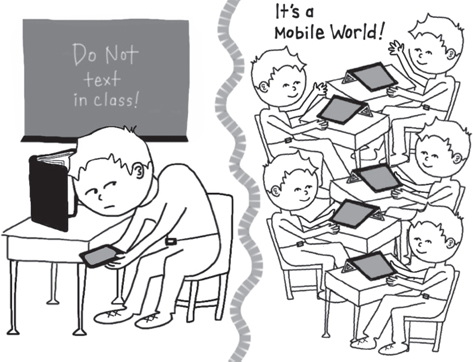CHAPTER 6
Instructional Management and Levels of Technology Access
According to a 2014 Pew poll, almost every American school today can technically be defined as a bring your own device (BYOD) school, whether that is the official policy or not. Approximately 77 percent of students of all ages admit to carrying cell phones to school.1 However, since more than 80 percent of students cannot use their devices in the classroom,2 the infiltration of mobile devices has become a behavior-management nuisance. Easily accessible distractions such as texting and social media often win in the battle for students’ attention, which begs the question: If they're using their mobile devices anyway, why not encourage and teach productivity and responsible use? In essence, that question has fueled the recent mobile learning movement. Instead of fighting against the current mobile movement and trying to hold back the wave with a policy banning mobile devices, mobile learning programs suggest proctoring and monitoring the use of mobile devices, bringing them out of the backpack, and more importantly, above the desk (as seen in Figure 6.1).

Figure 6.1 Bringing Mobile Devices above the Desk
Approximately one-third of students nationwide have school-issued mobile devices, and mobile adoption is increasing rapidly.3 Relying on best practices, anecdotal words of wisdom, and a careful implementation plan, ...
Get Mobile Learning: A Handbook for Developers, Educators, and Learners now with the O’Reilly learning platform.
O’Reilly members experience books, live events, courses curated by job role, and more from O’Reilly and nearly 200 top publishers.

